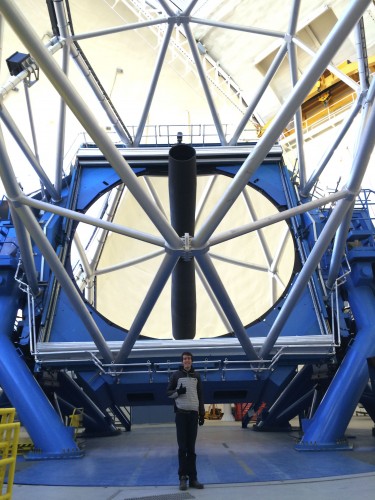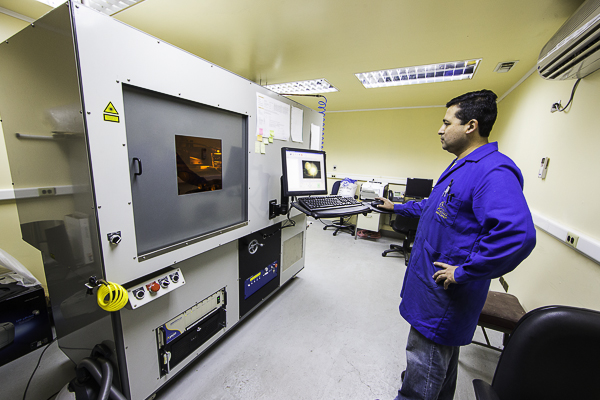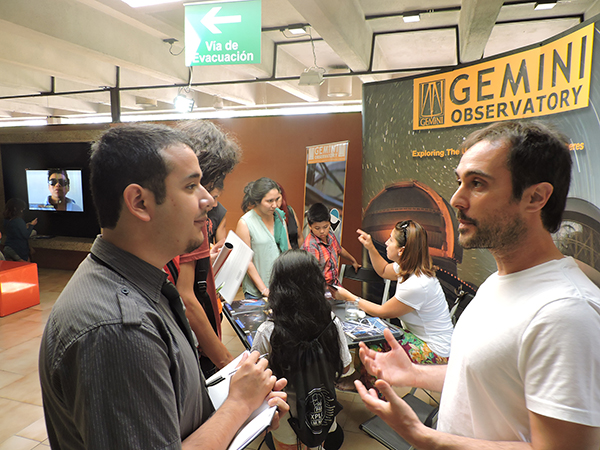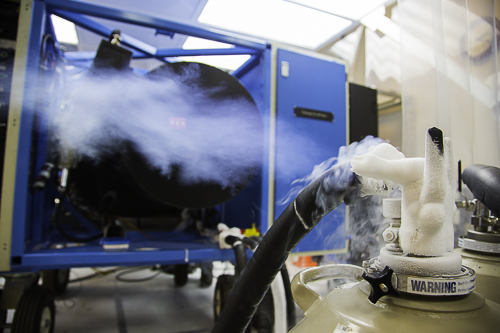- Date: 14 Apr 2015
- Comments: (0)
- Categories: For Astronomers, Operations News
- Date: 23 Mar 2015
- Comments: (0)
- Categories: Human Interest
Gemini North Intern Profiles
David Wyrick

David Wyrick poses in front of the Gemini North telescope on a recent observing run.
Find out now if there is an internship that is right for you, and don’t forget to subscribe for notification as new internships become available!
Other interns previously featured this year…
Marcel Dussert
Samuel Castle & Alex Gagliano
Jorge Quinteros
Día Nacional de la Astronomía en Chile
Este fin de semana, Chile celebra el Día Nacional de la Astronomía con actividades en diversas partes del país. Las actividades centrales se realizarán en el Planetario de la Universidad de Santiago (USACH). Varios miles de estudiantes han visitado la muestra desde ayer en Santiago. Empleados de distintos observatorios astronómicos se integran a la actividad en Santiago, La Serena y Vicuña incluyendo a Gemini, Cerro Tololo y Cerro Mayu. En La Serena, Gemini coordinó (en conjunto con la Municipalidad local, la Oficina de Protección de los Cielos del Norte (OPCC), la Universidad de La Serena, Cerro Tololo y los Observatorios Cerro Mayu, y Alfa Aldea, talleres educativos gratuitos para la comunidad en temas tan variados como la espectrografía, astrofotografía, lectura de mapas estelares y leyendas de arqueoastronomía. En Vicuña, el Planetario Natural Alfa Aldea ofrecerá charlas en 3D la noche del sábado y posteriormente los presentes podrán observar con telescopios nuestros cielos. Quieres unirte y observar el cielo? https://www.youtube.com/watch?v=6w6V9wVKyVE
National Day of Astronomy in Chile
This weekend Chile celebrates the first annual National Day of Astronomy with activities in many parts of the country. The “core” activities are hosted by the University of Santiago Chile’s Planetarium. Already, several thousand students have participated in programming in Santiago. Staff from many Chilean observatories are joining in the fun in Santiago, La Serena, and Vicuña including Gemini, Cerro Tololo, and Cerro Mayu. In La Serena Gemini is co-sponsoring (along with the City Hall, The Light Pollution Protection Office, The University of La Serena, Cerro Mayu, Alfa Aldea and Cerro Tololo) a number of very popular educational workshops. These workshops cover diverse topics in spectrography, astrophotography, reading star maps, and archeoastronomy legends. In Vicuña the Natural Planetarium Alfa Aldea is hosting a 3-d astronomy talk series on Saturday night and providing telescope tours of our skies.
Do you want to join us and observe our skies? https://www.youtube.com/watch?v=6w6V9wVKyVE (video in spanish)
- Date: 20 Mar 2015
- Comments: (0)
- Categories: For Astronomers

In this image, Victor Pinto, Instrument Maker 2 from the AURA instrument shop, is operating the laser milling machine at the AURA recinto in La Serena, Chile.
Attention Users: Gemini Spectroscopic Mask Making Software was Updated February 27th.
A new version of Gemini’s Mask Making Preparation Software is now available. This update supports both Gemini Multi-Object Spectrographs (GMOS) at Gemini North (GN) and Gemini South (GS) detector configurations.
Once updated, users can expect improvements in efficiency and compatibility (older version mask designs may be rejected by Gemini). For more on the software’s major changes, please visit the mask-making software website.
GMOS (North and South) offers the ability to obtain spectra of several hundred objects simultaneously in their Multi-Object Spectroscopic (MOS) modes. The GMOS MOS design is based upon precisely fabricating and locating a plate containing many small slits within the spectrograph’s entrance aperture. Typically a single mask can have between 30-60 slits; or, if a narrow-band filter is used, you can have several hundred slits per mask. A total of 18 masks can be loaded into GMOS at any given time. Actual mask production for GN and GS is done with a laser milling machine located in La Serena, Chile.
- Date: 19 Mar 2015
- Comments: (0)
- Categories: Español, For Astronomers, Operations News
Flamingos-2 Prepares for a Date with the Universe
After a series of updates (and maintenance) to further improve performance, the mid-infrared imager and spectrograph Flamingos-2 (F2) is back on the Gemini South telescope in preparation for queue observations. Gemini scientists, engineers, and technicians worked in collaboration at the Cerro Pachón instrument lab over the last week in preparation. F2 is now equipped with a new spectroscopic filter (to access longer wavelengths), and focal plane mask (a new slit) which is narrower and longer than the ones regularly available on the instrument. The team also fixed the alignment of a baffle that is intended to block thermal radiation from the “bridge valve” which was adversely impacting data. F2 is currently in the telescope and taking science data.








